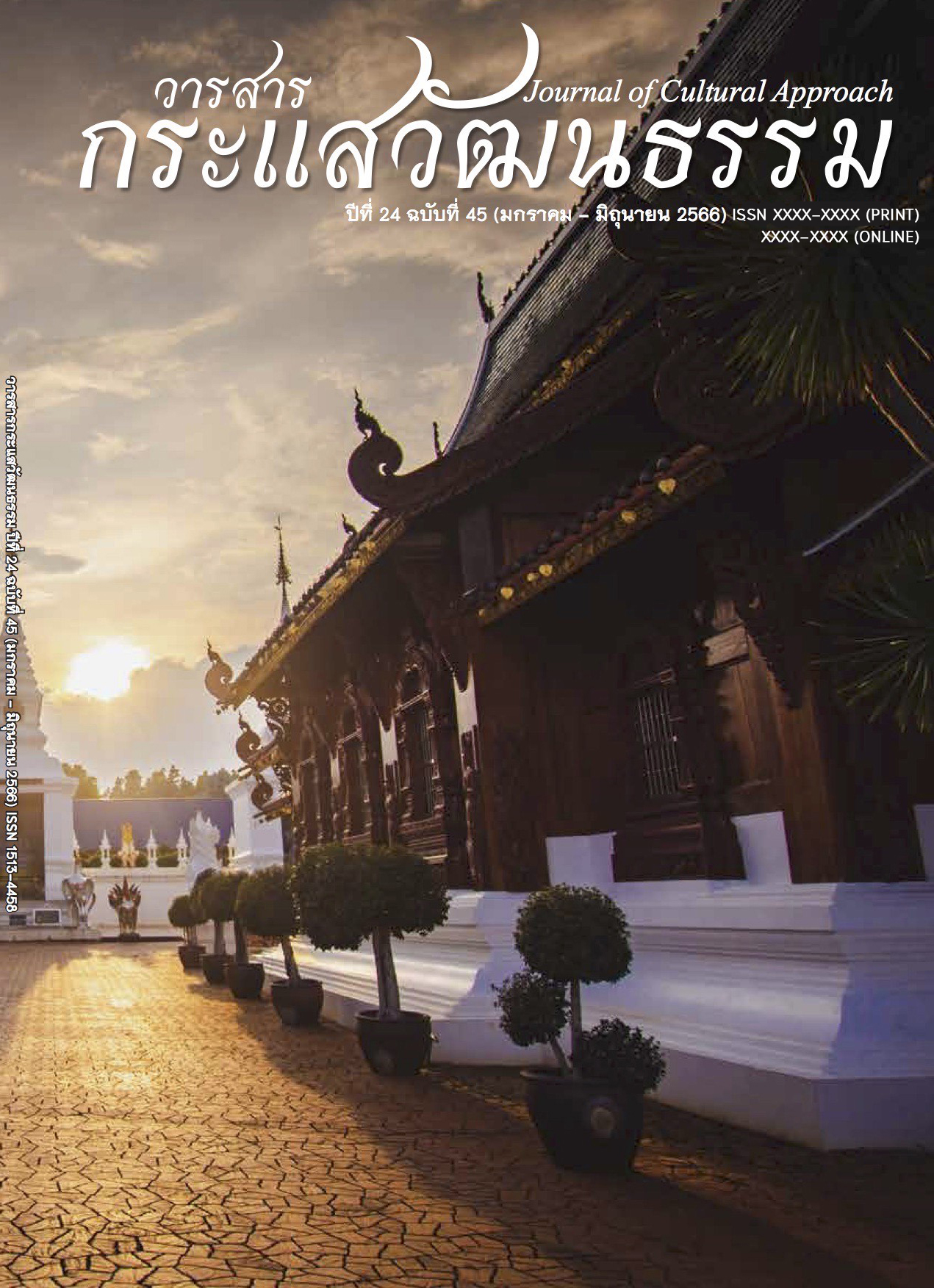Songkhla Old Town Architecture and Storytelling on Canvas: the Process of Knowledge Integration through Storytelling as Cultural Heritage Value and Sustainable Design
Main Article Content
Abstract
The purpose of this research was: 1) to research and develop the process of fabric design to create cultural heritage values with the concept of storytelling, 2) to propose a model of integrating fabric design and storytelling to create cultural heritage values through the products of study areas, and 3) to assess fabric patterns and souvenir identity and satisfaction by evaluating the suitability of the pattern and product styles from design experts, residents in the Songkhla old town, and research samples by using questionnaires and interviews.
Research findings indicated that the overall satisfaction of fabric pattern design was at a high level (= 4.19) and that the satisfaction of souvenirs when considered in each product found that cloth was at the highest level (
= 4.53), followed by hats and bags (
= 4.40,
= 4.23), respectively. The researcher laid out the guidelines for designing souvenir products for sale, and they must have beauty along with adding content about the old town’s architecture story, which is representative of Songkhla’s souvenirs. In order to help cultivate awareness of Thai cultural values, and be a part of the continuation of Thai culture for sustainability and modernity at the same time, products must respond to current market needs and be produced locally.
Article Details

This work is licensed under a Creative Commons Attribution-NonCommercial-NoDerivatives 4.0 International License.
Proposed Creative Commons Copyright Notices
1. Proposed Policy for Journals That Offer Open Access
Authors who publish with this journal agree to the following terms:
- Authors retain copyright and grant the journal right of first publication with the work simultaneously licensed under a Creative Commons Attribution License that allows others to share the work with an acknowledgement of the work's authorship and initial publication in this journal.
- Authors are able to enter into separate, additional contractual arrangements for the non-exclusive distribution of the journal's published version of the work (e.g., post it to an institutional repository or publish it in a book), with an acknowledgement of its initial publication in this journal.
- Authors are permitted and encouraged to post their work online (e.g., in institutional repositories or on their website) prior to and during the submission process, as it can lead to productive exchanges, as well as earlier and greater citation of published work (See The Effect of Open Access).
Proposed Policy for Journals That Offer Delayed Open Access
Authors who publish with this journal agree to the following terms:
- Authors retain copyright and grant the journal right of first publication, with the work [SPECIFY PERIOD OF TIME] after publication simultaneously licensed under a Creative Commons Attribution License that allows others to share the work with an acknowledgement of the work's authorship and initial publication in this journal.
- Authors are able to enter into separate, additional contractual arrangements for the non-exclusive distribution of the journal's published version of the work (e.g., post it to an institutional repository or publish it in a book), with an acknowledgement of its initial publication in this journal.
- Authors are permitted and encouraged to post their work online (e.g., in institutional repositories or on their website) prior to and during the submission process, as it can lead to productive exchanges, as well as earlier and greater citation of published work (See The Effect of Open Access).
References
Inkong, P. (2019). Cultural Product Design Concept Style Analysis. Unlimited Printing.
Keawpan, T., Itsaranuwat, S. & Plangnok, J. (2020). Principles and Concepts in Product Design. Journal of Humanities and Social Sciences Surin Rajabhat University, 22(2), 161-182.
Lertcharnrit, T. (2011). The Creative Cultural Resource Management. Princess Maha Chakri Sirindhorn Anthropology Centre (Public Organisation).
National Institute of Thai Wisdom and Education (NITWE). (1999). Concepts and Case Studies of Guidelines for Promoting Wisdom in Foreign Countries. T.P. Print Company Limited.
Office of Natural Resources and Environmental Policy and Planning (ONEP). (2021). Old Community. Bangkok.
Phanadamrong, E. (2016). Storytelling. Siriraj Medical Bulletin, 9(3), 194–196.
Pichayasoonthorn, P. (2013). Foundation of Design. Chulalongkorn University,
Rattana, E. (2019). Thailand Cultural Heritage of Movies Registered as National Films Heritage. Thammasat University.
Sariya, P. (2006). Decorative Design. Odean Store.
Sopakanee, B. (2020). Development of Souvenir-Jewelry Product From Cultural Capital By Conjoint Analysis Technique. Srinakharinwirot University.
Srimarat, T. (2015). Cultural Identity and Commodification: A Case Study of Ping Nakara Boutique Hotel and Spa, Chiang Mai. Chiang Mai University.
Sriton, A. & Tularuk, U. (2021). Sacred Water and Cultural Communication of Phu Wiang Mountain Community,Wiang Kao, Khon Kaen. The 22nd National Graduate Research Conference, Khon Kaen University.
Tantiset, K. (2014). The Commodification of the Candle Festival of Ubonratchathani. Journal of Interdisciplinary Research: Graduate Studies, 3(1), 137-150.
Thanapornpun, R. (2006). Investigate Arts, Reinforce Sciences, Create Creations. Mr.Copy.


